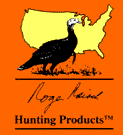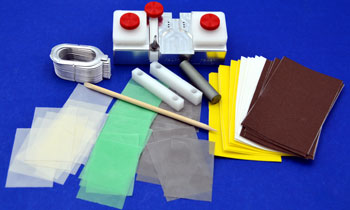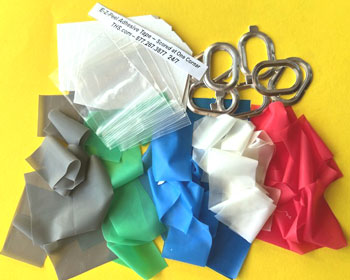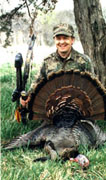Breaking Up A Flock
Copyright © 1998 - 2021 Roger
W. Raisch * Nadine Adele, all rights reserved
|
The SECRET
to being successful on almost all fall turkey hunting outings is to roost a flock the
night before the actual hunt. The second-best method is
finding a flock in early morning before they have flown down. If neither can be
done, flocks can be flushed during the day, but getting them properly separated is often
very difficult.
|
How To Flush
Birds At Night
|
You should be in the
expected roosting area at least one hour before sundown.
On a clear, calm day turkeys will start flying up to roost around sundown. On a
cloudy, stormy, dark day they will go to roost earlier. The experienced turkey
hunter can use these facts to great advantage. For example, if you do not hear
turkeys fly up within a few minutes of sundown, chances are good that you are not close to
a flock. You should move quickly to another roost area to listen. Listen from
the top of the major ridge system in the area. You can more quickly along a ridge
than across hollows.
|
As the birds start
flying up you will hear the flapping of wings and noise from small branches breaking as
the birds land. These sounds are distinctive, but must
be heard a few times before they become familiar. Smaller wing flapping sounds will
be heard as some birds fly to higher limbs or they are chased to another limb by another
member of the flock. As the flock starts to settle down you may hear a few birds cluck softly to each other. If you have
not roosted any birds and it is past fly up time, you may get an answer from a roosted
bird by making a few clucks or kee-kees with your turkey call.
|
Assuming you have
heard birds fly up or they answered your calls, the next steps are every bit as important
as locating the flock. Wait at least 20 minutes after
sundown before trying to flush the flock, 30 minutes in late fall when the leaves are off
the trees. If you try to flush a flock too early, the birds
will see and hear you coming and fly away together in the same general direction. You want them to go in many different directions. After it is darker, your chances for a proper separation are
greater. In early fall when young birds haven't had many encounters with humans, and
when leaves still remain on the trees, the birds may not flush easily.
|
How To Execute
The Flush
|
When the time has
come to flush the flock, do it quickly and quietly. Walk steadily and be as quiet as
possible as you approach them. When you see or hear
the first bird flush, start running toward them. After more birds start flying,
begin yelling and making as much noise as possible. If you have a gun along, fire a
shot or two into the air to flush the birds. If they generally fly off together,
fanning out onto the next ridge, move quickly to that spot and re-flush the birds to
separate them even further. When flushing turkeys that
are on roost or on the ground, try to approach them from above or on the same contour. If you approach from below, they will flush, but not scatter as
well as you want. If a flock is on the ground and you try to run uphill at them,
they will run rather than flay and you won't be able to catch up. You will get
closer and scatter turkeys best if they are approached from above or on their level.
|
Flushing Turkeys
In Early Morning Or During The Day
|
Despite your efforts
to roost a flock of turkeys, you will return home often without the foggiest idea of where
the birds are. You will not know what to do the next morning. Try being in another likely roost area at least 30 minutes before sunrise
the following morning. Listen
for turkeys to start calling on their own or try to get a roosted bird to sound off by
making tree yelps, clucks, kee-kees, kee-kee-runs or yelps with your caller. Listen for only a few soft tree yelps, clucks, a yelp or two or maybe a
single kee-kee-run in response. Keep moving through the woods, stopping in likely
roost or feeding areas to call. If you get a response and it is before fly down
time, or if the day is dark or overcast and you suspect the flock is still on roost, stalk
quietly and quickly to get close. When you see or hear
the roosted birds start to fly, flush them in the previously
described manner.
|
If you don't locate
turkeys by fly down time, the task of separating a flock properly is more difficult. Continue stalking through the woods, stopping near feeding areas to call. Even if birds do not respond you may hear them scratching in the
leaves on a quiet day. Once you have located turkeys, stay out of sight as you make
your slow, quiet stalk. Try to get as close as possible to the flock or get ahead of
them in a position where they will pass by. If you are
going to try to flush the flock you need to be as close as possible--within 50 yards. As soon as you are close enough, or the birds start to run or fly because
they have detected you, run at them as hard as you can. The gun hunter can fire a
round or two in the air to get the turkeys flying. If the flock does not split
adequately, follow them immediately and go quickly to the place where they landed.
Many will have landed in trees and you should flush them again.
|
How To Read The
Flush
|
The proper
evaluation of a flush will help you determine what calling and hunting tactics to employ. Time of day, the number of turkeys, their age and sex and how well
they separated are questions that need to be answered. The first issue to decide is
whether the turkeys were separated well. If not, you will be wasting valuable time
calling and waiting for their return. If they scattered in all directions or if they
fanned out and you re-scattered them, they should return and be responsive to your
calling. On the other hand, if you simply scared them and they all ran or flew off
together and you didn't find them again, you'd better start looking for another flock to
hunt.
|
The number of birds
involved and their age and sex will determine what calls to make and gives you a general
idea as to when they may return. A flock numbering
greater than 10 usually indicates an old hen or two with young poults. A group of
18-month-old gobblers (last spring's jakes) will often number from 4 to 10, while old
gobblers will normally number from 2 to 8. But to be sure, try to observe the
turkeys before you flush them. What are they? Even in you are uncertain of
their age and sex, given a good scatter, you will have action at the appropriate time.
|
When and Where
Will The Flock Regroup?
|
The when part of
this question generally depends on the age and sex of the turkey flock and what time of
day they were separated. Young birds that have not been
hunted before will begin to assemble and call within 15 to 30 minutes if they are
separated at nearly any hour of the day. Young turkeys that are separated at night
will begin calling and regrouping at fly down time in the morning. If flushed off
roost before fly down time, they will usually begin calling within 30 minutes. If
scattered during the day, they will normally start calling within an hour. Old
gobblers will get back together when they feel like it. They are very
unpredictable. Even if scattered at roost time, they may take the better part of the
next day, or even longer, to regroup.
|
A scattered flock will
regroup near the original point of separation if they were split well and individual birds
went in several different directions. But remember, turkeys can't count, so some
birds may not return because they got together at the landing point and decided to stay
there.
|
Scatter A Fanned
Flock Again
|
A flock that fans
out in one direction and does not separate well needs to be followed up and flushed again. Most of the turkeys will be nearly back together. They can
see and hear one another easily and will regroup within a few minutes after they start
calling, leaving you empty-handed. A fanned-out flock
should be broken up again quickly after they land to achieve the desired results. Take your stand in the middle of the first landing spot.
Chances are good that birds will come back to that location to regroup.
|
Summary
|
There is no secret method
to predetermine the exact spot on which a flock will reassemble. I have witnessed
them get together in an open pasture, in the middle of deep woods, in an open glade or at
the edge of the woods. Make your best guess on where they are going to regroup, set
up quickly at that spot, start calling and hope for the best. With experience,
selecting the correct reassemble point will become easier. |
| |
|
| |
t

God Bless America
|
View
Cart & Check-Out
NOVEMBER
2025
877.267.3877
515.299.5388
24 / 7
WE answer
our
phones Personally!
|
|












